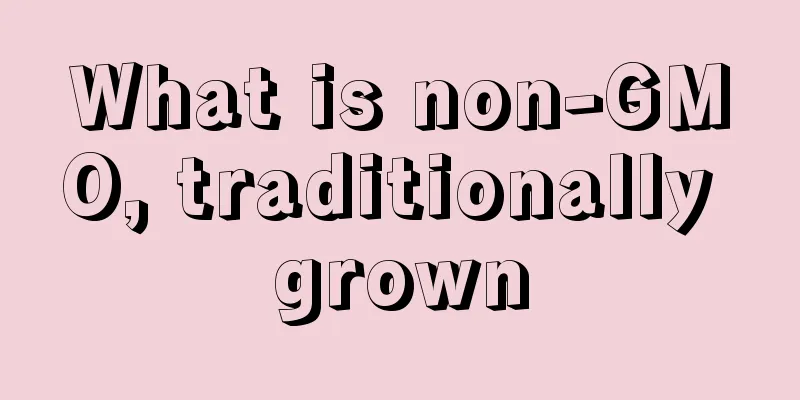What is non-GMO, traditionally grown

|
In the past, everything we ate was non-GMO, and was the healthiest and safest. But now our lives are about to be replaced by GMOs. Although GMO foods have advantages in some aspects, they can never be compared with non-GMO foods. 1. What is non-GMO It is not something that is genetically modified. To understand this question, we must first understand what genetically modified organisms are. Genetically modified organisms mean that scientists change the genes of animals and plants in laboratories and then create food types with new characteristics. For example, by adding an antifreeze gene from marine fish grown in the Arctic to ordinary tomatoes, this popular food can be preserved longer in the winter, greatly extending its shelf life. The topic of genetically modified foods quickly split into two camps. Those who support it believe that technological advances can greatly improve our living standards, while those who oppose it believe that genetically modified foods can cause unexpected poisoning or allergic reactions. 2. Genetically modified organisms 1. Artificial genetic modification Introducing artificially isolated and modified genes into the genome of an organism, The expression of the introduced gene causes the heritable modification of the characteristics of the organism. This technology is called transgenic technology. technology). The terms "genetic engineering", "genetic engineering" and "genetic transformation" that people often talk about are all synonyms for genetic modification. Nowadays, artificial technology for changing the traits of animals and plants is often called genetic modification technology (in a narrow sense), while the manipulation of microorganisms is generally called genetic engineering technology (in a narrow sense). Organisms modified by genetic engineering technology are often referred to as "genetically modified organisms" (GMOs) in the media. 2. Natural genetic modification It is not artificially directed, but a transgenic phenomenon that occurs autonomously in animals, plants or microorganisms in nature, such as lentiviral vectors The hepatitis B virus DNA is integrated into the chromosomes of human sperm cells, the bacteriophage inserts its own DNA into the lysogenic cell DNA, Agrobacterium and cauliflower mosaic virus (CMV), etc. 3. Plant genetic modification Transgenic plants are plants that contain foreign genes in their genome. It can be obtained through protoplast fusion, cell recombination, genetic material transfer, chromosome engineering technology, and may change certain genetic characteristics of plants to cultivate new crop varieties that are high-yield, high-quality, virus-resistant, insect-resistant, cold-resistant, drought-resistant, flood-resistant, salt-alkali-resistant, and herbicide-resistant, such as corn and rice. , Arctic avocado, and genetically modified triploid poplar. Moreover, transgenic plants or in vitro cultured cells can be used to produce expression products of exogenous genes. For example, genes such as human growth hormone, insulin, interferon, interleukin 2, epidermal growth factor, and hepatitis B vaccine have been expressed in transgenic plants. |
<<: What to do if you have toothache? These methods will teach you
Recommend
What to do if the wine cork breaks
Red wine usually comes with a bottle cap that is ...
Advantages and disadvantages of radiation therapy for skin cancer
Among skin cancers, basal cell carcinoma and squa...
The teacher accidentally scratched the child's face
When children reach a certain age, parents will s...
Membranous nephropathy stage II and uremia
I believe everyone is aware that uremia is a very...
How to prevent and treat periodontitis
In this appearance-oriented society, almost no on...
Advantages and disadvantages of blue light glasses
Nowadays, almost everyone cannot live without mob...
What causes stomachache and vomiting? Causes of stomach ache and vomiting
Stomach pain is a common symptom in life, but som...
How long can bean sprouts be kept in the refrigerator?
Bean sprouts are usually eaten directly after pur...
What causes snake egg sores
Herpes zoster is the common name for it, and its ...
Precautions in fibroid tumor care
There are many clinical diseases that are divided...
Three major benefits of soaking sea buckthorn in wine
Seabuckthorn is a wild fruit whose skin is covere...
Beware of asymptomatic liver cancer. There are several principles for choosing food for liver cancer
Mr. Cai, who is in his seventies, has always felt...
Who are the suitable people for American ginseng
American ginseng is an expensive Chinese medicina...
Long-term skipping changes in body shape
If you want to exercise, you don’t necessarily ha...
What is the breast cancer red medicine
What is Mercurochrome for Breast Cancer? 1. Durin...









